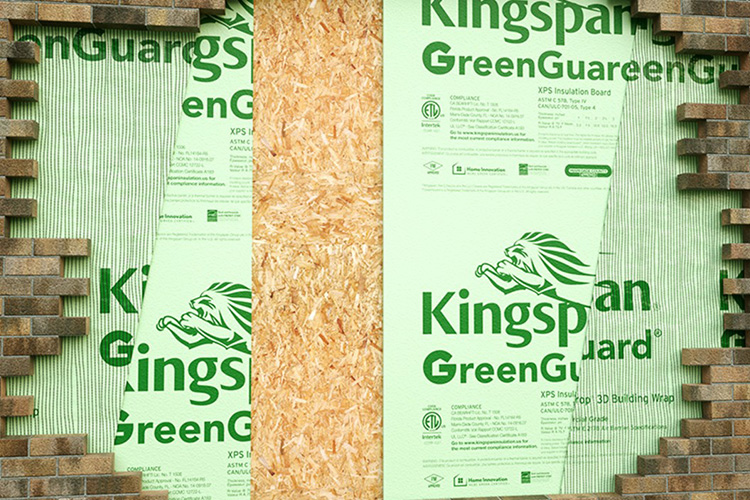Strategies and Materials to Combat Thermal Bridging
January 11, 2024
With escalating energy costs, the quest for efficient insulation materials that curtail energy transfer has intensified among homeowners and builders.
Even with superior insulation, the specter of thermal transfer lingers, especially when thermal bridging occurs between a structure's interior and exterior.
To thwart thermal bridging, creating a seamless, continuous insulation barrier around the building's exterior is paramount. Employing the right materials and strategies can accomplish this with efficacy and confidence.
Unlocking the Power of Rigid Insulation Panels
One compelling method to ensure continuous insulation and impede thermal transfer involves installing rigid insulation panels across the exterior. These panels, compatible with most cladding types, effectively stave off common sources of thermal bridging when installed correctly.
Enterprises like Kingspan offer a line of products specifically designed to combat thermal bridging by enveloping the exterior, including frames. Unlike insulation limited to between studs, these panels mitigate thermal bridging over uninsulated areas, curtailing energy loss.
Combatting Moisture Build-up with Insulated Sheathing
Insulated sheathing acts as a formidable opponent against thermal bridging by covering the entire exterior, encompassing framework and studs.
Manufactured by industry leaders like Kingspan, insulated sheathing comprising synthetic materials is engineered to resist moisture build-up. Its impermeability to air and moisture safeguards a building's performance, reducing energy loss attributable to thermal bridging.
Elevating Protection with Seam Tape
Even with insulating panels or sheathing, thermal bridging might persist at breaks in insulation. Seam tape intervenes by preventing air and moisture transfer at these points, upholding the integrity of continuous insulation.
Fortifying Your Roof's Defenses
Under-insulated or uninsulated roofs account for substantial heat and energy loss in buildings.
Incorporating insulation boards beneath roofing material effectively counters thermal bridging in roof design. This additional insulation layer not only curtails energy loss but also mitigates attic overheating, prevents ice dams, and extends the roofing material's lifespan.
Addressing Vulnerabilities: Windows and Doors
Any breach in a building's insulation, especially through windows and doors, presents an opportunity for thermal bridging.
Sealing seams around these openings with caulking, opting for insulating glass or foam-core doors, and utilizing insulating curtains or blinds are essential steps to mitigate energy loss through these areas.
Preventing Thermal Bridging with Continuous Insulation
Effectively combating thermal bridging remains pivotal in managing energy costs. Employing the appropriate continuous insulation methods across a building's entirety helps prevent this form of energy loss.
Homes fortified with robust continuous insulation not only improve efficiency but also enhance comfort, thereby augmenting their overall value. To delve deeper into this topic, explore the Kingspan knowledge article on Strategies and Materials to Prevent Thermal Bridging.
@KingspanIns_US #KingspanIns_US #Kingspan #Insulation #MoistureManagement
Company:  Kingspan Insulation LLC
Kingspan Insulation LLC
Product: Flashing
Tags:
Doors
"BILCO's Basement Doors: A Comprehensive Look at Innovative Design and Functionality" (November 16, 2023), Easily Identify Risks & Safeguarding Solutions for Commercial Overhead Doors (September 5, 2023), Enhancing Sound Control: The Versatility of Ambico's Acoustic Door & Frame Assemblies (July 12, 2023), Layering Physical Security Entrances to Protect Data Centers (May 23, 2023), Accuride’s linear track system perfect for large sliding doors, furniture large doors, partitions and more (March 31, 2023), Considerations when installing bullet-resistant frames (February 14, 2023), Fire rated door and frame assemblies (February 7, 2023), How to Get an Industrial Look with your Glass Wall Divider (November 30, 2022), Sensing solutions for hangar doors (September 19, 2022), The Pros and Cons of Fixed and Pivoting Glass Shower Shields (August 31, 2022)
Energy
Unlock Architectural Excellence with Sto Masonry Veneer Engineered Systems (MVES) (September 28, 2023), The Future of Energy-Efficient Homes: Embracing Panelized Construction (September 7, 2023), Exploring Huntsman Building Solutions' Trailblazing Environmental Product Declaration for HEATLOK HFO and HEATLOK Soya HFO: An Architect's Indispensable Resource (June 23, 2023), The results are in on the First-Ever US Collegiate Design-Build Passive House Ice Box Challenge with Pratt Institute School of Architecture (May 18, 2023), How it Works: Solaris® Cool Roof for Solar Reflectivity (May 5, 2023), OPG Announces New Mini Reactor In Darlington, Ontario (January 25, 2023), 4 Ways to Reduce Energy Costs in Commercial Buildings (January 2, 2023), Product Spotlight: ViuLite® Integrated Blinds (July 6, 2022), Mobile Hi-Impact Shielding Barrier for Industrial Applications (March 4, 2022), Daylighting Design: How Much Light Do You Need? (January 3, 2022)
Insulation
The Future of Energy-Efficient Homes: Embracing Panelized Construction (September 7, 2023), Exploring Huntsman Building Solutions' Trailblazing Environmental Product Declaration for HEATLOK HFO and HEATLOK Soya HFO: An Architect's Indispensable Resource (June 23, 2023), The Benefits of Translucent Panel Daylighting Systems (April 20, 2023), 4 Ways to Reduce Energy Costs in Commercial Buildings (January 2, 2023), No Masonry is Truly Waterproof (October 31, 2022), Why Spray Foam? Outlast and outperform fiberglass: cutting energy costs (September 9, 2022), Closed-Cell Insulation (June 15, 2022), Tyvek vs GreenGuard: Choosing the Best Housewrap for Your Project (February 9, 2022), Advantages of Insulated Sandwich Walls - Veterans Memorial Parkway Warehouse Project Feature (June 30, 2020), Moisture Control for Commercial Cladding (January 24, 2020)
Roof
Enhance Rooftop Safety with Heightwise Blog by LadderPort: A Comprehensive Guide (January 9, 2024), The Ultimate Snow Management Solution: Fusion-Guard, a Best-Selling Snow Guard for 20 Roof Types (November 14, 2023), Fall Protection Railing Systems (October 24, 2023), BILCO Roof Hatch Paves Way For Delivery of Important Medical Device (October 10, 2023), BlueWater: Ensuring Safe Rooftop Installations and Fall Protection Solutions for Schools and Universities (July 27, 2023), Alpine SnowGuards: Optimal Layout Recommendations for Pad-Style Snow Guards (July 19, 2023), How it Works: Solaris® Cool Roof for Solar Reflectivity (May 5, 2023), Using roof cover board to reduce outside sound transmission (February 21, 2023), LadderPort™ - the Safer, Less Expensive Alternative To Vertical Ladders (December 26, 2022), Roof hatches provide safe and convenient access to roof areas by means of an interior ladder, ship stair or service stair (December 19, 2022)
Sustainability
Unlock Architectural Excellence with Sto Masonry Veneer Engineered Systems (MVES) (September 28, 2023), The Future of Energy-Efficient Homes: Embracing Panelized Construction (September 7, 2023), Exploring Huntsman Building Solutions' Trailblazing Environmental Product Declaration for HEATLOK HFO and HEATLOK Soya HFO: An Architect's Indispensable Resource (June 23, 2023), Resources to meet sustainability requirements (March 29, 2023), StrataClean IQ Air Filtration System is quiet, energy-efficient and meets new EPA Clean Air in Buildings challenge recommendations (August 3, 2022), How to Showcase Your Business During the Winter with Planters (January 26, 2022), Recycled Planters, Light Poles, and Bases (November 29, 2021), Special shapes have an impact on architectural design (November 12, 2021), New SimpleSoffit™ Drywall Framing System from Armstrong Offers a Faster, Easier, Better Way to Build Soffits (May 19, 2021), LYRA PB Direct-Apply Acoustical Ceiling and Wall Panels provide sustainable and acoustical options (March 17, 2021)
Walls
Enhancing Moisture Management in Masonry Construction: The Innovation of Mortar Net Solutions (August 23, 2023), Introducing new brick colors: Beyond plain white, the Belden Brick Company expands design possibilities (June 15, 2023), Therm+ H-I Timber Curtain Wall Systems (November 21, 2022), No Masonry is Truly Waterproof (October 31, 2022), MortarNet™ with Insect Barrier™ - the original mortar dropping collection device (September 30, 2022), Flush, borderless grille installation for plaster and drywall applications (May 30, 2022), Daylighting Design: How Much Light Do You Need? (January 3, 2022), Ventilating the top and bottom of a cavity wall (August 4, 2021), Deflection, Drainage and Drying: the 3 basics of water management in a wall system (March 3, 2021), Rib Rock Landscape Block Provides Time and Costs Savings with Tightened Construction Schedule (December 9, 2020)
Windows
Navigating the Maze of Bulletproof Standards: Making Sense of NIJ, UL752, and ASTM (December 28, 2023), Elevating Construction Practices: Prefabricated Façade Panels with Built-in Windows (December 4, 2023), BILCO Roof Hatch Paves Way For Delivery of Important Medical Device (October 10, 2023), [Video] What To Do Before Bulletproofing Corporate Offices (June 7, 2023), Different Glass Enclosure Options for Offices (May 16, 2023), What framing materials are needed for bulletproof security windows? (April 25, 2023), Considerations when installing bullet-resistant frames (February 14, 2023), The Pros and Cons of Fixed and Pivoting Glass Shower Shields (August 31, 2022), The Wall-in-One Installation Solution (July 29, 2022), Take Performance to the Next Level with 2500 UT Unitwall® System and Triple-Pane Glass (June 22, 2022)


